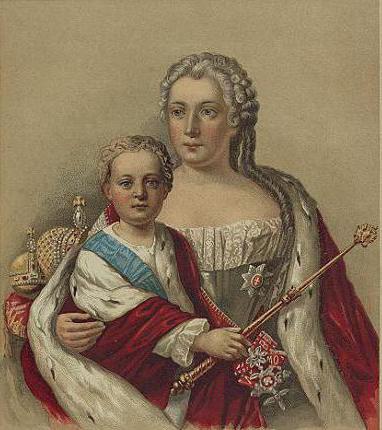In Russia, immediately after the death of Peter the Great, a stage began, which historians called the "period of temporary workers." It lasted from 1725 to 1741.
Russian throne
At this time, there was no one among the members of the royal dynasty who was able to hold on to power. And therefore she was in the hands of the court nobles - "temporary workers" or random favorites of the rulers. And although the heir to the throne formally stood at the head of Russia, all the questions were decided by the people who put him on the kingdom. As a result of the irreconcilable enmity of Peter's associates, Catherine I (Alekseevna), then Peter II, were in power one after another , followed by Anna Ivanovna and finally Ivan 6.
Biography
This almost unknown Russian emperor had virtually no right to the throne. He was just a great-grandson of Ivan V. Born in the summer of 1740, John Antonovich, just two months old, the manifesto of Anna Ivanovna was named emperor. His regent until coming of age was the Duke of Courland of Biron.

His mother Anna Leopoldovna - the eldest granddaughter of Catherine - was Anna Ioannovna's most beloved niece. This pleasant pretty blonde had a good-natured and gentle character, but at the same time she was lazy, sloppy and limp. After the fall of Biron, her aunt's favorite, she was proclaimed the Russian ruler. This circumstance was initially sympathetically accepted by the people, but soon this fact began to cause condemnation among the common population and the elite. The main reason for this attitude was that in the administration of the country key posts remained in the hands of the Germans, who came to power during the reign of Anna Ioannovna. According to the will of the latter, the Russian throne was received by Emperor Ivan VI, and in the event of his death - by seniority other heirs of Anna Leopoldovna.
But she herself did not even have an elementary idea of how to manage a state that is increasingly deteriorating in foreign hands. In addition, Russian culture was alien to her. Historians also note her indifference to the suffering and concerns of the common population.
The reign of Ivan VI
Dissatisfied with the dominance of German power, the nobles grouped around Tsarina Elizaveta Petrovna. Both the people and the guard considered her to be the liberator of the state from foreign control. Gradually, a conspiracy was beginning to mature against the ruler and, naturally, her baby. At that time, Emperor Ivan VI Antonovich was still a one-year-old child and understood little in court intrigues.
The impetus for the uprising of the conspirators, historians call the decision of Anna Leopoldovna to declare herself the Russian Empress. On December 9, 1741, a ceremony was scheduled. Having decided that it was no longer possible to procrastinate, Elizaveta Petrovna, with a group of guards loyal to her, on the night of November twenty-fifth, two weeks before this event, entered the Tsar’s palace. The whole Braunschweig surname was arrested: the little emperor Ivan VI, Anna Leopoldovna and her husband. Thus, the infant did not rule for long: from 1740 to 1741.
Insulation
The family of the former ruler, including the deposed John VI and his parents, Elizaveta Petrovna promised freedom, as well as unhindered travel abroad. At first they were sent to Riga, but they were taken into custody there. After that, Anna Leopoldovna was charged with being the ruler, she was going to send Elizabeth Petrovna to prison in a monastery. The little emperor and his parents were sent to the Shlisselburg fortress, after which they were transferred to the territory of the Voronezh province, and from there to Kholmogory. Here, the former king, who in official lifetime sources is referred to as John VI, was completely isolated and kept separately from the rest of his family.
"Famous Arrester"
In 1756, Ivan VI was transported again from Kholmogor to the Shlisselburg fortress. Here he was placed in a separate cell. The fortress of the former emperor was officially called the "famous prisoner." He, being in complete isolation, had no right to see anyone. This even applied to prison officials. Historians say that for the whole time of his imprisonment he was never able to see a single human face, although there are documents showing that the “famous prisoner” was aware of his royal origin. In addition, Ivan VI, who was taught incomprehensibly by someone, was always dreaming of a monastery. Since 1759, the prisoner began to show signs of inadequacy. Empress Catherine the Second, who met with John in 1762, confidently asserted this. However, the jailers believed that the former emperor was pretending.
Death
While Ivan VI was imprisoned, many attempts were made to free him in order to re-ascend to the throne. The last of them turned into death for a young prisoner. When in 1764, already during the reign of Catherine II, Lieutenant Mirovich, the guard officer of the Shlisselburg fortress, was able to win over most of the garrison, another attempt was made to free Ivan.
However, the guards - Captain Vlasyev and Lieutenant Chekin - had secret instructions to immediately kill the prisoner when they came for him. Even the Empress’s decree could not cancel this order, so in response to Mirovich’s harsh demands to surrender and give them a “famous prisoner,” they first stabbed him and only after they surrendered. The place where Ivan VI was buried is not known for certain. It is believed that the former emperor was buried there - in the Shlisselburg fortress.
Thus ended the fate of one of the most unhappy Russian rulers - Ivan Antonovich, whom historiographers also called John. With his death, the history of the tsarist branch ended, whose head was Ivan V Alekseevich and which did not leave behind either a good memory or glorious deeds.